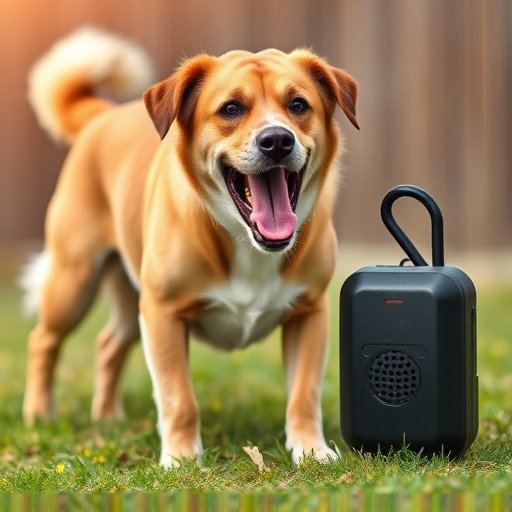Dog repellent devices, leveraging scent, sound, or electromagnetic fields, protect outdoor spaces from unwanted dogs, promoting pet safety and behavior modification. Key benefits include customizable settings, ease of installation, and long-lasting protection. Regular maintenance is vital, focusing on monitoring low battery warning signs like increased activation time or reduced responsiveness to ensure continuous control over barking dogs. Staying vigilant allows users to proactively replace or recharge batteries, maintaining the device's effectiveness for effective pet training.
Introducing our comprehensive guide to revolutionizing pet management with bark control devices. This article delves into the inner workings and advantages of these tools, highlighting how they can humanely train dogs to curb excessive barking. We explore the critical role of multiple range settings, offering peace of mind by ensuring continuous protection. Furthermore, we provide essential insights on identifying low battery warning signs and offer maintenance tips for optimal device performance.
- Understanding Dog Repellent Devices: How They Work and Their Benefits
- The Significance of Multiple Range Settings in Bark Control Devices
- Identifying Low Battery Warning Signs: Ensuring Continuous Protection
- Maintenance and Troubleshooting Tips for Optimal Device Performance
Understanding Dog Repellent Devices: How They Work and Their Benefits
Dog repellent devices are designed to deter dogs from entering or lingering in specific areas, offering a humane and effective alternative to traditional scare tactics. These devices operate on various principles, including scent, sound, and electromagnetic fields. For instance, ultrasonic dog repellents emit high-frequency sounds that are unpleasant to dogs but often imperceptible to humans. On the other hand, motion-activated sprinklers use water to startle and displace dogs, while some devices release scents that dogs naturally avoid.
The benefits of using a dog repellent device are numerous. They can help protect gardens, patios, and other outdoor spaces from unwanted canine visitors without causing harm or stress to the animals. Additionally, these devices often come with adjustable settings, allowing users to customize the sensitivity and range according to their needs. Moreover, they are convenient and easy to install, providing a long-lasting solution for dog owners facing persistent barking or trespassing issues. Keep an eye out for low battery warning signs, as regular maintenance ensures optimal performance.
The Significance of Multiple Range Settings in Bark Control Devices
In the quest for effective pet training and behavior modification, bark control devices have emerged as valuable tools. One of their most significant features is the ability to offer multiple range settings. This versatility is crucial in diverse scenarios, especially when dealing with dogs in various environments and situations. For instance, a device designed for outdoor use should have a longer range to cover a larger area, ensuring consistent behavior modification for dogs roaming in extensive yards or public parks.
Multiple range settings also cater to different user needs. Dog owners training their pets in specific areas might opt for shorter ranges to focus on targeted zones without affecting nearby spaces. Additionally, the feature serves as a safety net, with low battery warning signs indicating when the device’s effectiveness may wane. This prompt action allows users to recharge or replace batteries before the device becomes ineffective, ensuring continuous control over their dog’s barking.
Identifying Low Battery Warning Signs: Ensuring Continuous Protection
When it comes to effective dog repellent devices, battery life is a critical factor for continuous protection. Identifying low battery warning signs is essential to ensure your Dog Repellent remains operational and can continue to protect your desired areas. Look out for subtle changes in device performance; for instance, if the device seems less responsive or takes longer to activate, it could be an indicator of a depleting battery.
Regularly checking the device’s power level and understanding these signs can help prevent any sudden failures. Many modern dog repellent devices come with smart features that notify users when the battery is low, allowing for prompt replacement or recharging. Staying vigilant and heeding these warning signs will ensure your Dog Repellent provides consistent protection, keeping unwanted intruders at bay.
Maintenance and Troubleshooting Tips for Optimal Device Performance
Regular maintenance is key to keeping your bark control device running smoothly and effectively. Check the battery level regularly, as a low battery can cause the device to malfunction or not activate when needed. Look for warning signs such as dim lights, slower response times, or an inability to transmit signals. Replace the batteries promptly to avoid any disruption in training.
Troubleshooting common issues can also help maintain optimal device performance. If the device isn’t emitting the intended sound or spray, double-check the settings and ensure they are correctly adjusted for your desired range. Clean the device regularly, removing any debris that might interfere with its operation. Additionally, keep an eye out for any physical damage, as a cracked casing or damaged components can affect its functionality. Regular maintenance and quick troubleshooting will help ensure your bark control device remains a reliable tool in training your dog.
A bark control device with multiple ranges offers adjustable protection tailored to various environments, ensuring both effectiveness and convenience. By understanding how these devices work and maintaining them properly, owners can benefit from their positive impact on behavior modification while avoiding potential issues like low battery warnings. Regular checks and simple troubleshooting techniques enable continuous protection, making these tools valuable additions for responsible dog ownership.
